Applied Materials, Inc. (NASDAQ:AMAT) Q4 2023 Earnings Call Transcript November 16, 2023
Applied Materials, Inc. beats earnings expectations. Reported EPS is $2.12, expectations were $1.98.
Operator: Welcome to the Applied Materials’ Earnings Conference Call. During the presentation, all participants will be in a listen-only mode. Afterwards, you will be invited to participate in a question-and-answer session. I would now like to turn the conference over to Michael Sullivan, Corporate Vice President. Please go ahead, sir.
Michael Sullivan: Good afternoon, everyone, and thank you for joining Applied’s fourth quarter of fiscal 2023 earnings call. Joining me are Gary Dickerson, our President and CEO; and Brice Hill, our Chief Financial Officer. Before we begin, I’d like to remind you that today’s call contains forward-looking statements which are subject to risks and uncertainties that could cause our actual results to differ. Information concerning the risks and uncertainties is contained in Applied’s most recent Form 10-Q filing with the SEC. Today’s call also includes non-GAAP financial measures. Reconciliations to GAAP measures are found in today’s earnings press release and in our quarterly earnings materials, which are available on our website at ir.appliedmaterials.com.
Before we begin, I have a calendar announcement. On Tuesday evening, December 12, Applied will lead a panel on the future of logic near the IEDM Conference in San Francisco. Joining us will be leading technology executives from Intel, Samsung, and TSMC, along with Google, Qualcomm, Synopsys, and the EV Group. There won’t be a webcast. So we hope you’ll join us in San Francisco. And with that introduction, I’d like to turn the call over to Gary Dickerson.
Gary Dickerson: Thank you, Mike. Before we begin, I’d like to speak briefly about Israel. As many of you know, Applied Materials has had a significant presence in Israel for nearly 30 years. We were shocked by the terrorist attacks of October 7 and the outbreak of war with its immeasurable suffering and loss. Our team in Israel is proving their resilience at this dangerous time and Applied Materials is committed to do our part to help our families stay safe until more peaceful conditions return. Now turning to our results. We delivered a strong finish to fiscal 2023 with record earnings in our fourth quarter and record revenue earnings and cash flow for the year as a whole. I would like to recognize the hard work and commitment of our global team to deliver these outstanding results.
As this is our year end call, I’ll begin my prepared remarks by reviewing our performance and key accomplishments over the past 12 months. I’ll then talk about our longer-term growth thesis for the industry and Applied before concluding with our outlook and priorities for 2024. While semiconductor and wafer fabrication equipment spending were both down in 2023, Applied was able to demonstrate the strength of our broad portfolio, as well as the central role we play enabling major industry inflections. Our Semiconductor Systems business delivered mid-single digit growth for the fiscal year and remains on track for growth in calendar 2023 which will be the fifth consecutive year that we’ve outperformed the wafer fab equipment market. We believe we can sustain this outperformance over the coming years, thanks to the leadership positions we’ve established at the major technology inflections that will enable our customers’ roadmaps.
In the past 12 months, many of our business units delivered new records and major milestones, including Etch where we passed 10,000 shipments of our Sym3 chamber. We also released new products and secured incremental production tool of record positions and Gate All Around, Backside Power Delivery, patterning advanced DRAM and High-Bandwidth Memory and heterogeneous integration. At the same time, we strengthened our ICAPS business that serves IoT, Communications, Auto, Power and Sensor customers with new products and application wins in etch, epitaxy, implant as well as metrology and inspection. In Services, we delivered low-single digit revenue growth in fiscal 2023, overcoming headwinds, including lower fab utilization rates and trade restrictions.
In this period, our total installed base increased 5%. In fact, our installed base of process chambers is now more than twice as big as our nearest competitor. In addition, there are more than 14,000 tools that are not chamber based including CMP, implant, and metrology and inspection. We grew the number of tools under long-term subscription agreements which now generate 63% of our total parts and service revenues. We also maintained the renewal rate of these subscriptions at 90%. In 2023, we continued to focus on our operations and supply chain, and we’ve made significant and sustainable improvements. Compared to this time last year, we are providing customers with better on-time delivery and shipment quality, while normalizing our inventory levels.
More importantly, our operations are ready to scale as the industry grows over the years to come. Across the company, we’re in a great position to enable our customer success and profitably grow Applied Materials as this next era of industry expansion takes shape. Looking to the future, there are four key components of our growth thesis. First, we believe that semiconductors will outgrow GDP as a digital transformation of the global economy progresses. Second, we expect the market for wafer fab equipment to grow as fast or faster than the market for semiconductors. This is because the industry roadmap is becoming more complex and chipmakers need to deploy more technology to move from one node to the next. Third, we believe that Applied will outperform wafer fab equipment because the key technology inflections are enabled by materials science and materials engineering where Applied has the broadest, most connected and most enabling portfolio of solutions.
And fourth, we believe we can grow our service business as fast or faster than our equipment business by providing customers with advanced service solutions that accelerate technology transfer from R&D to high volume manufacturing and optimize device performance, yield, and cost in their fabs. By identifying major industry inflections early and making strategic multiyear investments in our product portfolio and capabilities, Applied Materials is best positioned to benefit from this exciting period of industry innovation and growth. We have by far the broadest portfolio of unit process technology to address our customers’ high value problems in transistor, interconnect, 3D memory, specialty devices, and heterogeneous integration. We’re able to combine these technologies in unique ways to create co-optimized and integrated solutions, and we are seeing strong pull from our customers to work on higher value module and device integration problems.
At no time in our history have we been closer to our customers. We have built a unique platform for a collaborative innovation and commercialization of next-generation technologies. We will significantly expand this collaboration platform with EPIC, enabling Applied and our partners to innovate the way we innovate. And our advanced technology enabled service offerings are seen by customers as increasingly valuable, especially during technology transfer and fab ramp. These advanced services also provide growing subscription revenue streams for Applied. Moving to our near-term outlook and priorities for the year ahead. While we are mindful of the complex macroeconomic and geopolitical environment, we see demand for Applied products remaining robust with some changes within the mix.
In 2024, we expect demand from our leading edge foundry logic customers to be stronger year-on-year, underpinned by higher PC, cloud, and AI data center spending as well as the initial build-out of Gate-All-Around nodes. We see demand for our ICAPS business being lower, mainly due to softness in the industrial automation and automotive end-markets. In DRAM, both pricing and utilization are improving for our customers and we see demand for Applied’s products remaining strong. And we believe NAND spending will be up year-on-year, but still far below 2022 and less than 10% of wafer fab equipment spending overall. We expect NAND to remain a lower percentage of the wafer fab equipment mix moving forward. In terms of the global trade environment, the October 2023 export control rule changes in the U.S. were primarily focused on alignment with other countries.
The rules are complex and while we are working with the government to clarify certain details, we see no incremental material impact to Applied at this time. As I look ahead, I strongly believe that Applied Materials has the right capabilities, strategy and partnerships. In fiscal 2024, our major focus areas include driving R&D programs to further differentiate our portfolio and extend our leadership at the key inflections that enable future industry growth, continuing to make operational and supply chain improvements to better serve customers, capture economies of scale and drive productivity across the enterprise, and ensuring that as we scale the company, we continue to reduce our environmental impact in-line with Applied’s collaborative Net Zero playbook as announced earlier this year.
Before I hand over to Brice, let me summarize. In fiscal 2023, Applied grew our semiconductor equipment and service businesses even though our markets were down year-on-year. For calendar 2023, we were on track to outperform the wafer fab equipment market for the fifth year in a row. We believe this outperformance is sustainable, thanks to our strong positions at all the key industry inflections, the strength of our customer collaborations and growing demand for our advanced services. And we remain positive about our long-term growth opportunities, where we expect semiconductors to grow faster than GDP, wafer fab equipment to grow as fast or faster than semiconductors, Applied to outperform the wafer fab equipment market and our Service business to grow as fast or faster than equipment sales.

Now, I’ll hand over to Brice.
Brice Hill: Thank you, Gary, I’d like to start by thanking our teams for delivering record results this year and for making sustainable operational improvements in our inventory management, manufacturing linearity and on-time delivery performance. On today’s call, I’ll summarize our results for the fiscal year and Q4 as well as provide our guidance for Q1. Before going into the results, I’ll share my perspective on our unique business model and how it creates attractive returns for our long-term shareholders. Applied creates value by directing nearly $3 billion of annualized R&D into one of the most important markets of the world, semiconductors. Because we have the broadest and deepest equipment portfolio and expertise, we are invited to work closely with our customers as a trusted partner to identify and holistically solve their most valuable technical challenges.
Our R&D spending helps customers modify materials at atomic levels and on an industrial scale to deliver better semiconductors and end products for strategic growth markets like artificial intelligence. Our relationships with our customers provide us with insights in the end-market and technology roadmap trends and allow us to focus our spending on projects that have a high probability of commercial adoption and strong financial returns. As a result of the R&D invested in our customer success, we now have line of sight to market share leadership and growth across the key semiconductor manufacturing inflections, including Gate-All-Around, Backside Power, heterogeneous integration, high-bandwidth memory and 3D DRAM. The strategies we use to help solve challenges in leading-edge logic and memory are also being deployed in the ICAPS markets where our growth in 2023, more than offset weakness in NAND and leading edge logic.
ICAPS is also a strategic growth market fueled by powerful trends like edge computing and renewable energy. Applied’s focused and effective R&D investments have led to fantastic results for our shareholders. Over the past 10 years, we’ve grown revenue at a compound rate of over 13%, non-GAAP EPS at nearly 30% and free cash flow at 33%. We’ve increased our quarterly dividend per share at a compound rate of more than 12% over this period, and earlier this year, we announced our belief that our free cash flow can support doubling our previous dividend per share over the next several years. Looking ahead to the next 10 years, we expect semiconductors to grow faster than GDP. We expect the equipment market to grow as fast or faster than semiconductors due to increasing technical complexity.
We expect Applied’s equipment business to outgrow the market due to our strong portfolio of products and solutions that are squarely targeted at the highest value inflections. And we expect our Services business to grow as fast or faster than our equipment business as we help our customers generate increasing value from the industry’s largest installed base of more than 48,000 tools. Next, I’ll summarize our fiscal year results. On a year-over-year basis, revenue increased nearly 3% to a record $26.5 billion. Non-GAAP gross margin increased 20 basis points to 46.8% as our value based pricing and cost improvement actions more than offset the impact of inflation. Non-GAAP OpEx increased 13% to $4.69 billion, with the majority of the increase in R&D.
Non-GAAP operating profit declined 2% to $7.72 billion and non-GAAP operating margin decreased 140 basis points to 29.1%. Non-GAAP EPS increased 4.5% to $8.05 per share. We generated record operating cash flow of $8.7 billion, and record free cash flow of $7.6 billion. Shareholder distributions were approximately $3.16 billion. We paid $975 million in cash dividends and used approximately $2.2 billion to repurchase 18 million shares at an average price below $123 per share. We remain committed to returning 80% to 100% of free cash flow to shareholders over time and returned 87% over the past three years. Now I’ll summarize our Q4 results. On a year-over-year basis, net sales of $6.72 billion were slightly lower. Non-GAAP EPS rose 4% to a record $2.12.
Non-GAAP gross margin increased 130 basis points to 47.3%, and non-GAAP OpEx grew 8.8% to $1.19 billion with around two-thirds of the increase in R&D. Turning to the segments. Semi systems revenue declined 3% year-over-year to $4.88 billion and segment non-GAAP operating margin was flat at 36.9%. For the full year, semi systems grew revenue by 5% and outperformed the market, delivering record net sales overall and in foundry logic as well as in implant, packaging, Metals Deposition and CVD. Applied Global Services revenue grew 4% year-over-year in Q4 to a record $1.47 billion and segment non-GAAP operating margin grew 100 basis points to 29.3%. For the full year, AGS revenue increased 3%, demonstrating how the underlying growth drivers of the business, more than compensated for the trade restrictions enacted in October of 2022, along with fab utilization rates that declined over the past year.
AGS growth is a function of three things. The number of tools in the installed base, the increase in service intensity as process complexity increases, and the number of subscription agreements which increased revenue per tool. In 2023, we increased the installed base by 5%. And we increased the percentage of tools under service agreement by 3 percentage points to 16,600. An important catalyst for AGS is that we are adding entirely new kinds of subscription agreements including sensor and AI-based solutions in areas like tool matching for fab ramp acceleration. In Q4, we signed a unique environmental services agreement under which a large number of process tools and sub fab resources are connected to Applied eco-efficiency hardware and software products, all delivered as a service that helps our customers reduce electricity consumption and carbon emissions.
In addition, we recently signed our largest global comprehensive service agreement ever. Finally, AGS continues to produce more than enough operating profit to pay the company’s dividend. Moving now to Display. Q4 revenue increased to $298 million and segment non-GAAP operating margin increased to 22.5%. We continue to expect the Display cycle and Applied’s Display business to improve modestly in 2024, and we look forward to our opportunity to drive OLED technology into the laptop and tablet markets in 2025. Turning to cash flows in Q4. We generated nearly $1.6 billion in operating cash flow and nearly $1.25 billion in free cash flow. We distributed nearly $968 million to shareholders including $268 million in dividends and $700 million in buybacks.
We repurchased 5 million shares at an average price of $138.54. Next, I’ll discuss our business in China. As Gary indicated, we do not expect an incremental material impact from the recently updated trade rules. Our business in China grew as expected in Q4, largely due to an increase in trailing edge DRAM shipments that contributed close to $500 million in revenue. In Q4, our overall revenue in China was 44% of company sales. For the full year, revenue in China was 27% of sales with Semi systems sales in China composing 20% and AGS and Display sales in China the remaining 7%. We believe equipment demand in China is likely to remain healthy for an extended period because China’s domestic manufacturing capacity remains significantly below its share of worldwide semiconductor demand.
In addition, while nameplate fab capacity is growing in China, effective capacity is likely to remain below industry averages for some time until product and process yields gradually improve. Now, I’ll share our guidance for Q1. We expect our revenue to be $6.47 billion, plus or minus $400 million and we expect non-GAAP EPS of $1.90, plus or minus $0.18. Within this outlook, we expect Semi systems revenue to be $4.7 billion with ongoing strength in trailing edge DRAM. We expect AGS revenue to be $1.46 billion and Display revenue should be around $235 million. We expect non-GAAP gross margin to be approximately 47% and non-GAAP operating expenses to be around $1.23 billion. We are modeling a tax rate of 13%. Thank you. And now, Mike, let’s begin the Q&A.
Michael Sullivan: Thanks, Brice. Our goal is to help as many of our analysts as possible. With that in mind, please ask just one question on today’s call. If you have another question, please requeue, and we’ll do our best to come back to you later in the session. Operator, let’s please begin.
Operator: [Operator Instructions] Our first question comes from the line of Stacy Rasgon from Bernstein Research. Your question please.
See also 11 Best Vanguard Stocks To Buy and 10 Biggest Courier Companies in the World.
Q&A Session
Follow Applied Materials Inc (NASDAQ:AMAT)
Follow Applied Materials Inc (NASDAQ:AMAT)
Stacy Rasgon: Hi, guys. Thanks for taking my question. I’m sure you saw the news report that came out pretty much coincident with your earnings release from Reuters that talked about a potential investigation into your China shipments to SNEC. It also mentioned though, that you’ve already disclosed on October — in October ’22, a potential subpoena. I was just wondering, can you tell us like what is going on here? What did you actually disclose around potential legal issues related to your shipments in China around the export controls at this point? And I mean, I don’t know whether you can comment on this report or not, but any comment you might have on the news article, would be helpful. I don’t think you had much time to put it in the script.
Brice Hill: Stacy, hi. It’s Brice. Thanks for the question. We did disclose last year in our K that we’ve received a subpoena from the U.S. Attorney’s Office, and they requesting information related to certain shipments to China. Well, we would say is, we’re fully cooperating with the government on this matter. And of course, we’re — we remain committed to complying to all of the trade rules. And as you can imagine, because this is an ongoing legal matter, we can’t add to any of the comments that are out there at this point but it’s been a regular disclosure for us.
Stacy Rasgon: So there’s nothing new though. This is all related to whatever was already going on?
Brice Hill: Yeah. I just can’t add any comments to this. But yes, we did disclose this last October, I believe.
Stacy Rasgon: Got it. Thank you.
Operator: Thank you. One moment for our next question. And our next question comes from the line of Vivek Arya from Bank of America. Your question please.
Vivek Arya: Well, thanks for taking my question. You mentioned that you expect China demand to stay healthy. And I’m trying to understand what that means because you did have these incremental DRAM shipments. So, I guess the first specific question is, what are you assuming for those DRAM shipments in your January quarter outlook? And should we understand from your China strength comment that your China sales conceptually could stay at least flattish next year or could they even grow? Just high level, what does, stay strong mean to you as it comes to the sales impact in fiscal ’24?
Brice Hill: Hi, Vivek. Yeah. So for Q1, in particular, as you highlighted, we did see elevated shipments to China. In Q4, it was 44% of our sales mix. In Q1, we expect it to be elevated again. We’ll continue to ship DRAM products at a high level in Q1 and when we think about the mix for China for the rest of ’24, we’re not ready to give a guide yet, but most of this business is ICAPS business and it’s been very strong growth for ’22 and ’23 for us. For ’24, we expect it to be a strong — still strong. It may not be as strong as it was in ’23, but China is the largest component to that. So again, we’re not ready to guide that, but our Q1 guide, you will still see an elevated mix for China.
Gary Dickerson: Hi, Vivek. This is Gary. Just also what Brice said on the prepared remarks was for the full year China was 27% and actually it’s down a little bit. But really pretty much same zip code as it was in the previous year. And as we go through the year, we would think it gets more back to the historical averages.
Vivek Arya: Thank you.
Operator: Thank you. One moment for our next question. And our next question comes from the line of Chris Caso from Wolfe Research. Your question please.
Chris Caso: Yeah. Thank you. Just another question on the ICAPS. Just unpacking some of what you said. So perhaps you could talk to the non-China part of the ICAPS business. It sounds like that’s where you’re seeing a little bit of incremental weakness, again in line with some of your customers. And then, as — I guess along with that with what you just said is trying to coming back to the historic averages. Is that a function of, just other business growing as opposed to China going down?
Brice Hill: Okay. Thanks, Chris. On the second part, I think the reason China comes back to its normal average is around 30%. It’s just because the elevated DRAM shipments will normalize after Q1. So we had high DRAM in Q4. We expect that in Q1 and that should slow down and after that it will be, mostly ICAPS business again. And then, thinking of ICAPS In general, what I would say again is, we had significant growth in ’22, significant even higher growth in ’23. So when we think long-term, we’re expecting mid to high-single digits of growth for ICAPS across several years. And to your point, looking right now this year, Q1 is actually a strong guide for ICAPS, but we do see lower utilization. We have seen some push-outs from different customers as they re-time some of their fab projects.
And we did see the lower utilization in Q4. So we do think that Q — our ’24 will be a strong year for ICAPS but may not be as strong as ’23, but again it’s, it’s much higher than it was in ’22 because of the growth cycle that has gone through.
Chris Caso: Got it. Thank you.
Operator: Thank you. One moment for our next question. And our next question comes from the line of Toshiya Hari from Goldman Sachs. Your question please.





